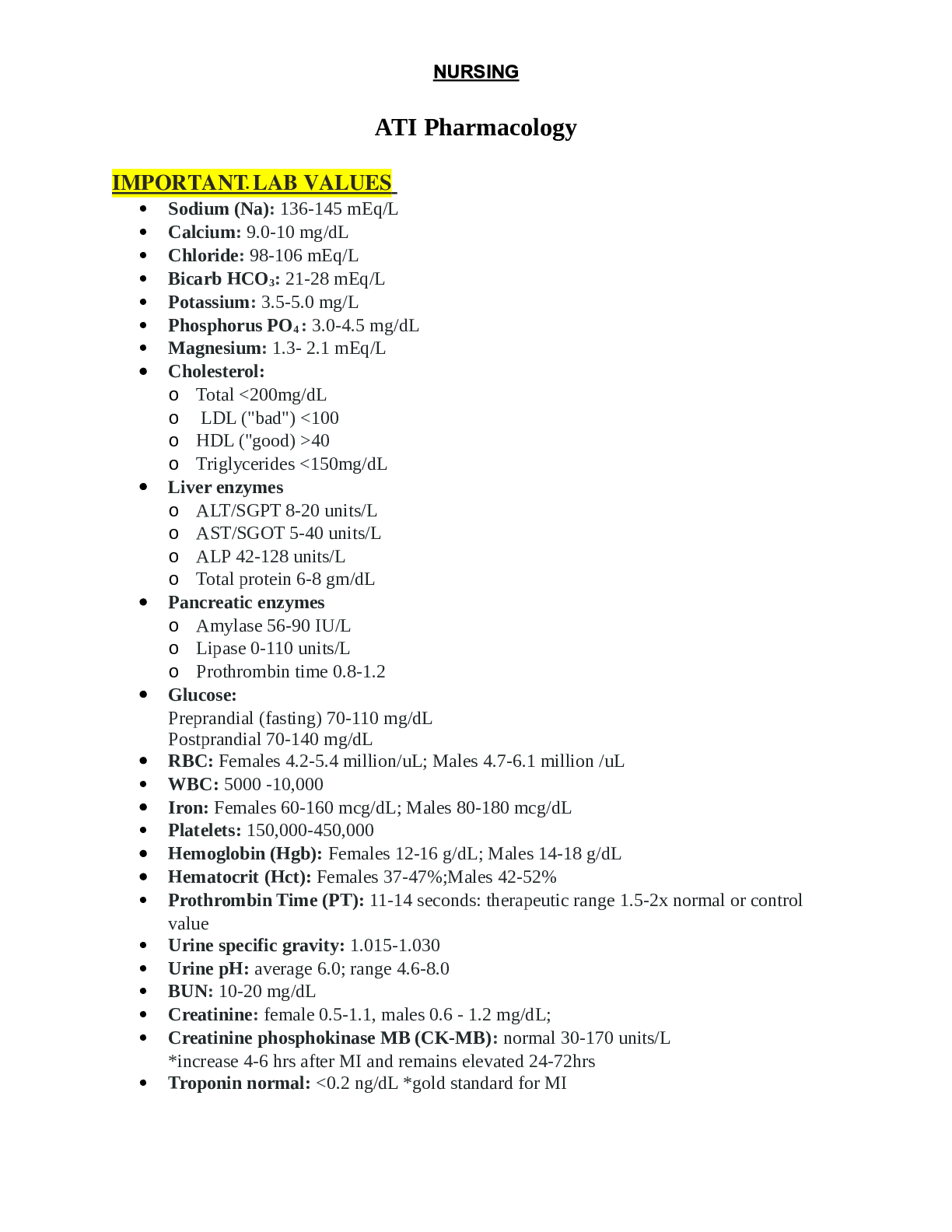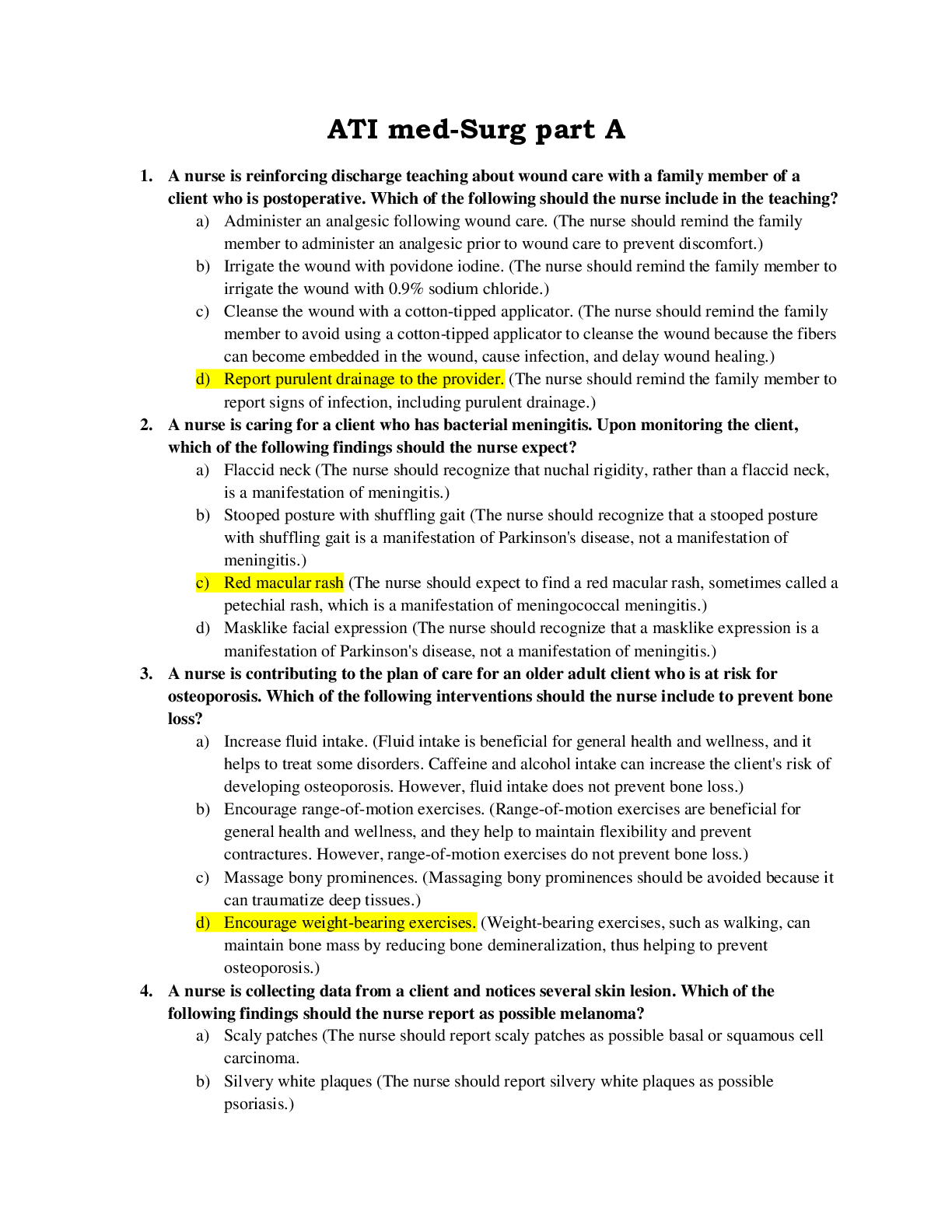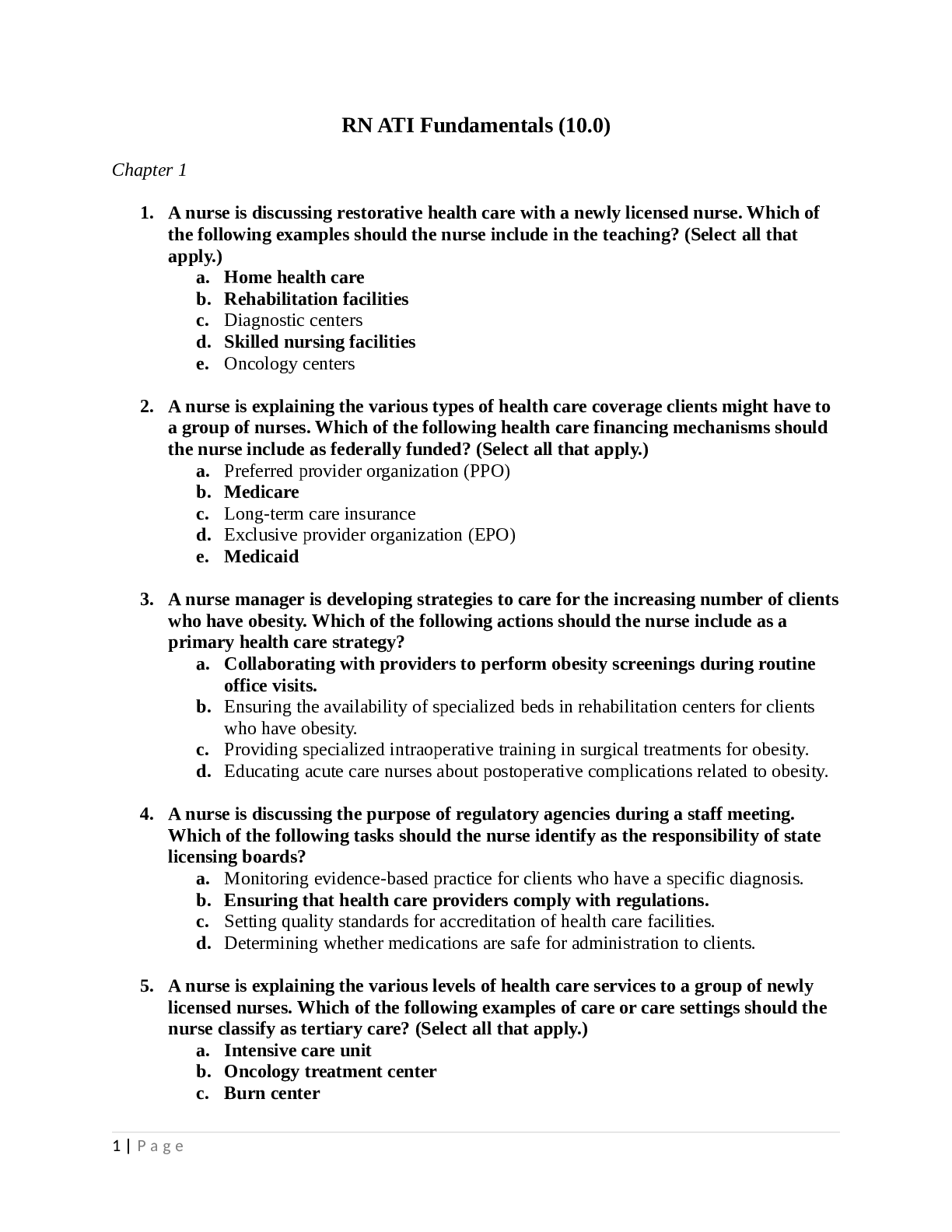ATI Active Learning Template (Medication) - Oxytocin (Pitocin)
Document Content and Description Below
ATI Active Learning Template (Medication) - Oxytocin (Pitocin) ATI Active Learning Template (Medication) - Oxytocin (Pitocin) Category/Classification: ● Therapeutic: hormones ● Pharmacologic... : uterine stimulants; oxytocics Review Module: ATI Pharmacology Chapter 32 - Medications Affecting Labor & Delivery Expected Pharmacological Action: Action: Stimulates uterine smooth muscle, producing uterine contractions similar to those in spontaneous labor. Has vasopressin and antidiuretic effects. Therapeutic Effects: Induction of labor. Control of postpartum bleeding. Therapeutic Use: IV: Induction of labor at term. IV: Facilitation of threatened abortion. IV, IM: Postpartum control of bleeding after expulsion of the placenta. Complications: Maternal adverse reactions are noted for IV use only. ● CNS: ● maternal—COMA, SEIZURES; ● fetal, INTRACRANIAL HEMORRHAGE. ● Resp: ● fetal—ASPHYXIA, hypoxia. ● CV: ● maternal— hypotension; ● fetal, arrhythmias. ● F and E: ● maternal— hypochloremia, hyponatremia, water intoxication. ● Misc: ● Maternal— ↑ uterine motility, painful contractions, abruptio placentae, ↓ uterine blood flow, hypersensitivity.Medication Administration: ● Induction/Stimulation of Labor IV (Adults): 0.5– 1 milliunits/min; ↑ by 1– 2 milliunits/min q 30– 60 min until desired contraction pattern established; dose may be ↓ after desired frequency of contractions has been reached and labor has progressed to 5-6 cm dilation. ● Postpartum Hemorrhage IV (Adults): 10 units infused at 20– 40 milliunits/min. IM (Adults): 10 units after delivery of placenta. ● Incomplete/Inevitable Abortion IV (Adults): 10 units at a rate of 20– 40 milliunits/min. Contraindications/Precautions: Contraindicated in: Hypersensitivity; Anticipated nonvaginal delivery. Use Cautiously in: OB:First and second stages of labor; slow infusion over 24 hr has caused water intoxication with seizure and coma or maternal death due to oxytocin’s antidiuretic effect. Nursing Interventions: Assessment: ● Fetal maturity, presentation, and pelvic adequacy should be assessed prior to administration of oxytocin for induction of labor. ● Assess character, frequency, and duration of uterine contractions; resting uterine tone; and fetal heart rate frequently throughout administration. If contractions occur 2 min apart and are 50– 65 mm Hg on monitor, if they last 60– 90 sec or longer, or if a significant change in fetal heart rate develops, stop infusion and turn patient on her left side to prevent fetal anoxia. Notify health care professional immediately. ● Monitor maternal BP and pulse frequently and fetal heart rate continuously throughout administration. ● This drug occasionally causes water intoxication. Monitor patient for signs and symptoms (drowsiness, listlessness, confusion, headache, anuria) and notify physician or other health care professional if they occur. ● Lab Test Considerations: Monitor maternal electrolytes. Water retention may result in hypochloremia or hyponatremia. Implementation: ● Do not administer oxytocin simultaneously by more than one route. IV Administration ● Continuous Infusion: Rotate infusion container to ensure thorough mixing. Store solution in refrigerator, but do not freeze. ● Infuse via infusion pump for accurate dose. Oxytocin should be connected via Y Site injection to an IV of 0.9% NaCl for use during adverse reactions. ● Magnesium sulfate should be available if needed for relaxation of myometrium.● Induction of Labor: Diluent: Dilute 1 mL (10 units) in 1 L of compatible infusion fluid (0.9% NaCl, D5W, or LR). Concentration: 10 milliunits/mL. Rate: Begin infusion at 0.5– 2 milliunits/min (0.05– 0.2 mL); increase in increments of 1– 2 milliunits/min at 15– 30-min intervals until contractions simulate normal labor. ● Postpartum Bleeding: Diluent:For control of postpartum bleeding, dilute 1– 4 mL (10– 40 units) in 1 L of compatible infusion fluid. Concentration: 10– 40 milliunits/mL. Rate: Begin infusion at a rate of 20– 40 milliunits/min to control uterine atony. Adjust rate PRN. ● Incomplete or Inevitable Abortion: ● Diluent: For incomplete or inevitable abortion, dilute 1 mL (10 U) in 500 mL of 0.9% NaCl or D5W. ● Concentration: 20 milliunits/mL. ● Rate: Infuse at a rate of 20– 40 milliunits/min. Interactions: Drug-Drug: Severe hypertension may occur if oxytocin follows administration of vasopressors. Client Education: ● Advise patient to expect contractions similar to menstrual cramps after administration has started. Evaluation of Medication Effectiveness: ● Onset of effective contractions. ● Increase in uterine tone. [Show More]
Last updated: 2 years ago
Preview 1 out of 3 pages

Buy this document to get the full access instantly
Instant Download Access after purchase
Buy NowInstant download
We Accept:

Reviews( 0 )
$9.00
Can't find what you want? Try our AI powered Search
Document information
Connected school, study & course
About the document
Uploaded On
Oct 08, 2021
Number of pages
3
Written in
Additional information
This document has been written for:
Uploaded
Oct 08, 2021
Downloads
0
Views
159















